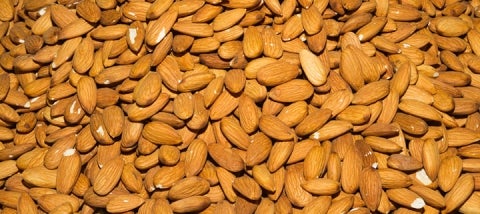Note: Yale School of the Environment (YSE) was formerly known as the Yale School of Forestry & Environmental Studies (F&ES). News articles and events posted prior to July 1, 2020 refer to the School's name at that time.

You’ve probably heard that the production of California almonds requires an immense amount of water — about a gallon per almond. But new research published in the Yale’s Journal of Industrial Ecology (JIE) reveals another, more favorable environmental dimension of almond production.
Compared with other nutrient- and energy-dense foods, almonds have a remarkably small carbon footprint — and could eventually become carbon neutral or even carbon negative.
In a multi-year lifecycle assessment analyzing energy use and greenhouse gas emissions associated with typical almond orchard production systems in California, a team of researchers found that 1 kilogram of almonds produces less than 1 kilogram of carbon emissions. (For comparison, the Environmental Working Group estimated that beef causes more than 20 kilograms of CO2-eq emissions, cheese more than 10, and beans and vegetables around 2.)
These results are driven largely by the use of almond co-products — including orchard biomass, hulls, and shells — as sources of renewable energy and dairy feed, said Alissa Kendall, Associate Professor of Civil Engineering at the University of California, Davis, and corresponding author for two new papers published in the JIE.
By improving the use of orchard biomass, California’s almond production could eventually become carbon neutral or carbon negative, she said.
“Almond orchards capture and store a significant amount of carbon both above and below the surface over their 25 year lifecycle,” said Kendall. “This carbon storage provides a climate benefit not considered in conventional carbon footprints.”
“This research doesn’t respond directly to concerns about water consumption, but it does show that almond production in California has a light carbon footprint,” said Reid Lifset, editor-in-chief of the Journal of Industrial Ecology. “Almond orchards can be a source of renewable energy and, as perennial crops, they store carbon during their life cycle — significantly offsetting carbon emissions in other stages of almond production.”
The findings were published in two articles. They can be downloaded for free here and here.
The Journal of Industrial Ecology is a bimonthly peer-reviewed scientific journal, owned by Yale University, published by Wiley-Blackwell and headquartered at the Yale School of Forestry & Environmental Studies.
Compared with other nutrient- and energy-dense foods, almonds have a remarkably small carbon footprint — and could eventually become carbon neutral or even carbon negative.
In a multi-year lifecycle assessment analyzing energy use and greenhouse gas emissions associated with typical almond orchard production systems in California, a team of researchers found that 1 kilogram of almonds produces less than 1 kilogram of carbon emissions. (For comparison, the Environmental Working Group estimated that beef causes more than 20 kilograms of CO2-eq emissions, cheese more than 10, and beans and vegetables around 2.)
These results are driven largely by the use of almond co-products — including orchard biomass, hulls, and shells — as sources of renewable energy and dairy feed, said Alissa Kendall, Associate Professor of Civil Engineering at the University of California, Davis, and corresponding author for two new papers published in the JIE.
By improving the use of orchard biomass, California’s almond production could eventually become carbon neutral or carbon negative, she said.
“Almond orchards capture and store a significant amount of carbon both above and below the surface over their 25 year lifecycle,” said Kendall. “This carbon storage provides a climate benefit not considered in conventional carbon footprints.”
“This research doesn’t respond directly to concerns about water consumption, but it does show that almond production in California has a light carbon footprint,” said Reid Lifset, editor-in-chief of the Journal of Industrial Ecology. “Almond orchards can be a source of renewable energy and, as perennial crops, they store carbon during their life cycle — significantly offsetting carbon emissions in other stages of almond production.”
The findings were published in two articles. They can be downloaded for free here and here.
The Journal of Industrial Ecology is a bimonthly peer-reviewed scientific journal, owned by Yale University, published by Wiley-Blackwell and headquartered at the Yale School of Forestry & Environmental Studies.
– Kevin Dennehy kevin.dennehy@yale.edu 203 436-4842
Published
July 23, 2015